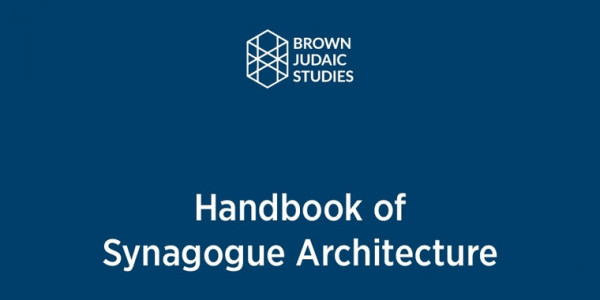Handbook of Synagogue Architecture
30/06/1982 | Na stronie od 18/05/2021

Source: Brown Judaic Studies
INTRODUCTION TO DIGITAL EDITION HANDBOOK OF SYNAGOGUE ARCHITECTURE
(pp. None) Marilyn J. Chiat
I began researching ancient synagogue architecture nearly fifty years ago for a doctoral dissertation that initially was to focus on what the architectural form or plan of the synagogue could tell us about its possible function or functions. I thus began my effort to track down as much information as was available on the ancient synagogue and quickly became aware of the dating controversies discussed in my introduction to the Handbook of Synagogue Architecture. It also became apparent that much of the evidence on excavated synagogue sites was either not published or not easily accessible. Few sites had final reports...
Introduction
(pp. 1-12)
The Handbook of Synagogue Architecture is a digest of the evidence from all known synagogue remains uncovered within the boundaries of ancient Palestine. Its purpose is to provide a research tool for archaeology, history and religious studies.
The handbook is divided according to the following seven regions and forty-four city-territories (or districts) formed by the Romans in the province of Palestine.
SECTION
A. PHOENICIAN CITIES
(pp. 13-18)
Although Tyre was considered by rabbinical authorities to lie outside the halakhic borders of Eretz Israel, Josephus (AJ XIV: 313-322) records the existence of a Jewish community in the city that may have settled there at the time of Hasmonean expansion along the Coastal Plain. Only scant archaeological evidence has been uncovered attesting to its presence. A capital decorated with a menorah was found at Mi'ilya (A:1, II-1); two other sites, Abrikha (A:1, IIIB-1) and Siddikin (A:1, IIIB-2), have remnants of buildings considered to be possible synagogues.
B. GALILEE
(pp. 19-148)
Josephus (BJ III:35) refers to two sections of Galilee, the Upper and the Lower, separated by the almost straight Beth ha-Kerem Valley and the deep gorge of the Amud Stream. The Romans took advantage of the natural topographic differences between the regions to establish two distinct political units: the southern urbanized Lower Galilee, and the rural, more religiously conservative Upper Galilee, known in ancient sources as Tetracomia (Georgii Cyprii, Descriptio Orbis Romane, ed. H. Gelzer, Lypsiae, 1890, no. 1040).
Comparatively little archaeological activity had been undertaken in the mountains of Tetracomia until a team led by Eric M. Meyers conducted...
C. COASTAL CITIES
(pp. 149-192)
The city of Dora, built on and around the mound known as Khirbet el-Burg, is south of the Carmel headland on the Mediterranean coast. It was first settled in the Late Bronze Age, and was continuously occupied through the Byzantine period.
Although Josephus (AJ XIX:300-312) records the desecration of the "chief synagogue" in Dora in 38 C.E., no evidence of Jewish occupation has been uncovered. Until recently, only very limited archaeological surveys and excavations have been conducted in this region.
The port of Caesarea, originally known as Straton's Tower, was founded by the Sidonians at the end of the Persian...
D. SAMARIA
(pp. 193-198)
The Romans formed the city-territory of Sebaste from the northern portion of the country called Samaria that had been controlled by the Samaritans since the time of the Assyrian conquest of Israel. Herod refounded the city in 27 B.C.E. and renamed it Sebaste, in honor of the emperor. He subsequently transformed it into a Hellenistic stronghold (Josephus, AJ VIII: 15, BJ I:21).
No Jewish evidence has been uncovered in the territory.
The formation of the city-territory of Sebaste by the Romans left the southern area of ancient Samaria in the control of the Samaritans. Because Samaritans chose not to support...
E. JUDAEA
(pp. 199-240)
The territory of Aelia-Capitolina, as Jerusalem was known in the Roman period, was carved out of a section of ancient Judaea (Judah), the southern half of David and Solomon's United Monarchy. It was refounded and renamed by Emperor Hadrian in 132 C.E., and was composed of four Judaean toparchies: Oreine, Gophitica, Herodium, and Bethleptepha. Hadrian expelled all Jews from the territory, but they were apparently allowed to return after his death (Smallwood, Jews, pp. 478-479).
The Babylonian Talmud (Ket. 105a) gives the number of synagogues in Jerusalem at the time of the first Jewish revolt (66-70 C.E.) as 394; the...
F. LIMES PALAESTINAE
(pp. 241-260)
The date of the formation of the Roman limes in Palestine (Limes Palaestinae) is uncertain. Soon after the first Jewish revolt, the Romans developed a line of forts along the Herodian frontier between Idumaea and Nabataea (Gechon Tiordeckai, "The Military Significance of Certain Aspects of the Limes Palaestinae," in Seventh International Congress of Roman Frontier Studies, 1967 [Tel Aviv, 1971], p. 191). The number of forts was increased at least twice more, until the entire Sinai region was turned into a Roman militarized zone intended to defend against Saracen attack. The forts, manned by military colonists who enjoyed a special...
G. EAST OF THE JORDAN RIVER
(pp. 261-328)
After the death of Agrippa I, the Romans made the territory of Caesarea-Philippi part of the Province of Syria where it remained until it was later transferred to Phoenicia (Jones, Cities, pp. 287-288). The city controlled a large expanse of territory that included a Jewish constituency; however, the city and territory were considered pagan in character (Jones, Cities, p. 282).
No Jewish material has been uncovered in the territory. A lintel decorated with a cross and menorah was found at Buriqa, but its attribution is unknown.